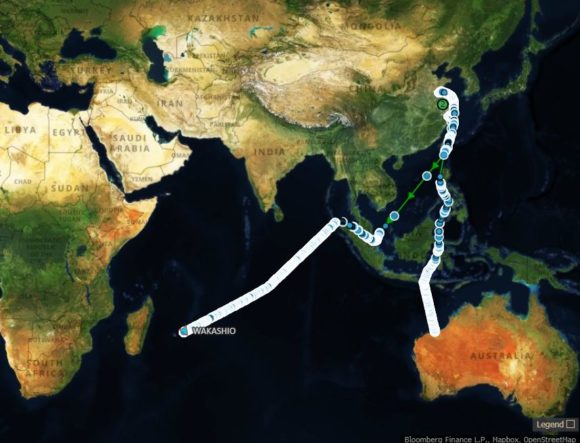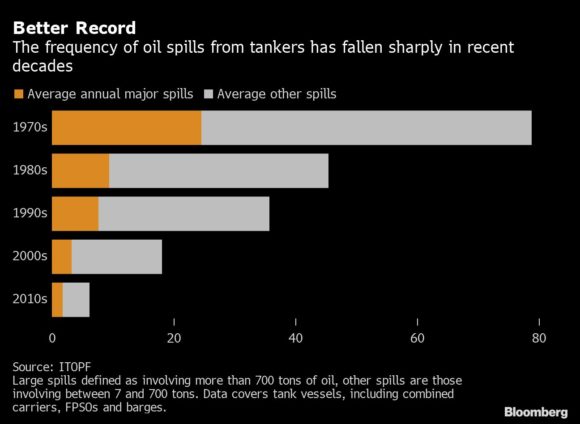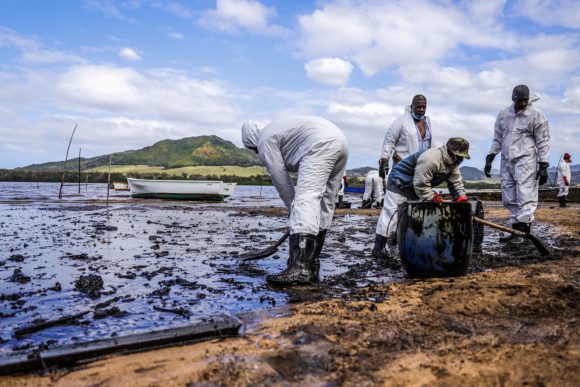The oil cleanup from a leaking cargo ship that ran aground off the coast of Mauritius continues while the government and insurance firms begin probing liability for the accident.
The incident has befouled the white-sand beaches of the Mauritian coast and left the Indian Ocean island nation facing widespread pollution. Its economy, which relies heavily on tourism, is already reeling from the coronavirus fallout and may be further affected by the spill.
The 300-meter-long vessel Wakashio was en route to Brazil from China when it ran ashore off the southeastern coast of the island of Mauritius on July 25. One of its five fuel oil tanks, holding about 1,180 tons, ruptured last week, resulting in more than 1,000 tons of fuel leaking into the ocean.

Japan P&I Club, which provided insurance for the ship’s owner, Nagashiki Shipping Co., said Tuesday that it’s investigating the extent of its coverage. The insurance will cover removal of the ship, as well as cleanup and other legal liabilities related to the owner, according to Japan P&I spokesman Koichi Miyahiro.
Mitsui O.S.K. Lines Ltd., which chartered the vessel, may be ordered by a local court to pay for environmental damages, said Tokai Tokyo Securities analyst Kenji Kanai. However, as a shipping insurance may cover these potential damages, “an impact on Mitsui OSK would not be big,” Kanai added. MOL, as the company is known, slipped as much as 5.1% in Tokyo on Tuesday.
Thousands in Mauritius rushed to contain an oil spill and prevent an ecological disaster after a Japanese-owned ship ran aground on a coral reef https://t.co/FSc6Iqtd1n pic.twitter.com/PIUf3TnssY
— Bloomberg QuickTake (@QuickTake) Aug. 10, 2020
Japan’s Nagashiki Shipping, the ship’s owner, said Monday that the transfer of oil to a nearby tanker is underway. Mauritian authorities have ordered two tankers — MT Elise and MT Tresta Star — and tugboats to assist with the removal of the fuel oil from the Wakashio, the Japanese company said. Japan said on Sunday it will send a six-person disaster relief team to assist with the oil leak.
Wakashio was carrying 3,894 metric tons of low-sulfur fuel oil, 207 tons of diesel and 90 tons of lubricant oil. There’s still almost 1,960 tons of fuel on board, according to Mauritius Prime Minister Pravind Kumar Jugnauth. While the ship has stopped leaking, the nation needs to prepare for “a worst case scenario,” Reuters quoted him as ssaying Monday.
For comparison, the 1989 Exxon Valdez oil tanker accident in Alaska spilled 37,000 tons of crude.
The ship, known as a capesize vessel designed to transport dry bulk cargoes such as iron ore, was not carrying a cargo, according to Kyodo News.
Large oil spills by tankers involving the release of more than 700 tons of fuel are becoming less frequent, averaging less than two a year since 2010, according to ITOPF, a shipowner industry group which acts as an adviser on clean-up operations and maintains data on incidents. The frequency of all spills of 7 tons or more of oil is also declining, down from an average of about 79 a year in the 1970s to less than 6 in the last decade.

Wakashio left Australia’s main iron ore shipping point of Port Hedland in early-June, and dropped off shipments at two Chinese ports, according to ship-tracking data compiled by Bloomberg. The ship departed China on July 4, refueled in Singapore around July 14 and was on its way to Brazil before running aground about 1 mile off the coast of Mauritius.
–With assistance from Stephen Stapczynski and David Stringer.
Photograph: People scoop leaked oil near Blue bay Marine Park in southeast Mauritius on Aug. 9, 2020. Photo credit: Daren Mauree/AFP via Getty Images.
Was this article valuable?
Here are more articles you may enjoy.



 Adjusters Launch ‘CarFax for Insurance Claims’ to Vet Carriers’ Damage Estimates
Adjusters Launch ‘CarFax for Insurance Claims’ to Vet Carriers’ Damage Estimates  Consumer Acceptance of Telematics Widens, Says Survey
Consumer Acceptance of Telematics Widens, Says Survey  Court Orders Justice Family Coal Companies to Pay $1M to Liberty Mutual Unit
Court Orders Justice Family Coal Companies to Pay $1M to Liberty Mutual Unit  SIAA Announces Strategic Partnership With Progressive
SIAA Announces Strategic Partnership With Progressive 

